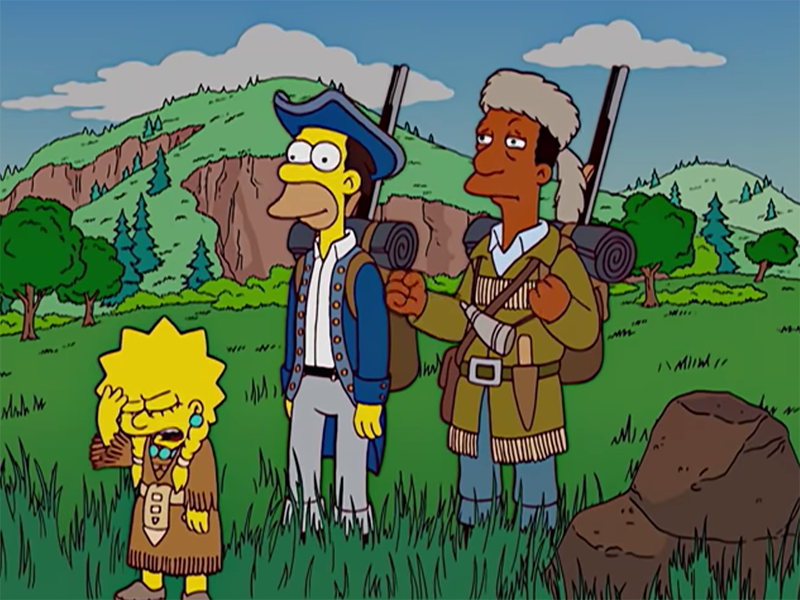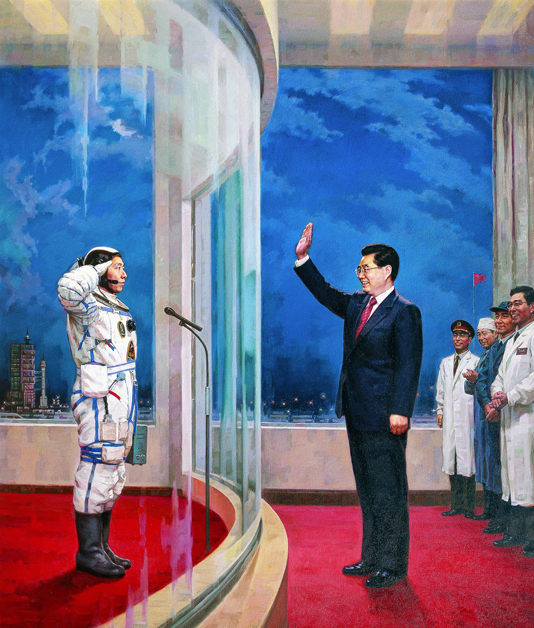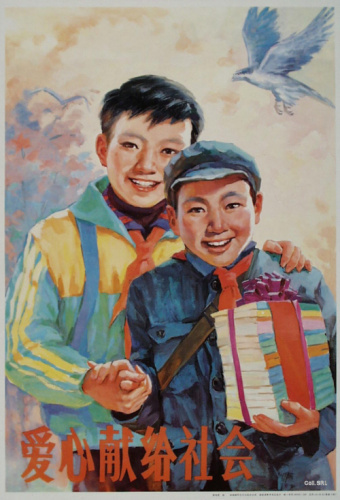Earlier this week, I received some comments from a reader regarding my research focus to “understand Chinese comics from the perspective of the present,” included in a previous post on this blog. The reader warned that this position could be interpreted as an expression of “presentism.” In light of this, I thought I might share some of my thoughts on this topic, as it relates to comics studies in China, and elsewhere as well.
As I understand it, “presentism” is a term that is used by historians and other scholars to criticize works appearing to be unduly influenced by the values and interests of their own historical moment. We often call these values and interests “cultural norms”, both in the sense that we tend to think of what we believe and care about to be “normal,” but also in the sense that values and interests shared by large groups of people are typically presented as also being “normative” — a standard to which other members of our society should aspire to.
Historians are primarily concerned with two tasks: first, accurately recording historical events; and second, interpreting the motivations of the historical actors responsible for those events. Presentism is less about the former (which we generally assume to be objective, although Hayden White and others might disagree on this point) and more about the latter. So, for example, a 20th century historian writing a history of Lewis and Clark’s 1803-6 expedition into the “void, the black land of desolation” (as one educational film has it) of the American West “from whence no man, foolhardy enough to venture into it might return” would likely discuss the inclusion of First Nations woman Sacagawea and African-American man York in the “Corps of Discovery [sic].” In our hypothetical historian’s account, they might suggest that Lewis and Clark were as much motivated by practical concerns for guiding, interpreting, and manual labor, as they were by more noble goals, such as protecting Sacagawea and her child from her “loving husband,” the abusive French fur trapper Toussaint Charbonneau. An interpretation along these might ignore or downplay the fact that both Sacagawea and York were enslaved, the former as a young child by a neighbouring tribe (“for the Indians she is less than property”), and the later from birth, as the son of man enslaved by Clark’s father.1
In a sense, presentism is foundational to comics studies, because the term “comics,” as we use it now, only emerged gradually. In its earliest sense, comics referred to cheaply printed humorous illustrated publications, after Thomas Hood’s The Comic Annual, which was published in 11 volumes (skipping a couple of years) between 1830 and 1842. By the 20th century, the term had largely come to refer instead to comic strips, or “the funnies”, published as a supplement in the Sunday papers; and somewhat later, comic books. In his biography of Rodolphe “The Father of the Comic Strip” Töpffer, David Kunzle dances around the term, often referring to Töpffer’s “picture stories,” contained in “comic albums.”2 Although I largely agree with Kunzle that comic strips as they emerged in the 19th century are probably best understood as a “narrative form of caricature,” the fact remains that, even when we can trace a direct line of genealogical descent from “picture story” to “comic strip,” it is unavoidably anachronistic to discuss the emergence of “comic strips” avant la lettre.
And the problem only gets larger the further back we go — consider, for example, Scott McCloud’s controversial claim that everything from Mayan codices to the Bayeux tapestry are “sequential art,” and by extension, “comics.”3 Just last week, Dirk Vanderbeke over at The Comics Journal provided an even more ecumenical account, building on Kunzle’s History of the Comic Strip, Vol 1: The Early Comic Strip. Narrative Strips and Picture Stories in the European Broadsheet from c. 1450–1825.4
My favorite example of the comics-are-older-than-you-think genre comes from Umberto Eco’s short essay “Verso un nuovo Medioevo” (Living in the New Middle Ages):
The Middle Ages are the civilization of vision, where the cathedral is the great book in stone, and is indeed the advertisement, the TV screen, the mystic comic strip that must narrate and explain everything, the nations of the earth, the arts and crafts, the days of the year, the seasons of sowing and reaping, the mysteries of the faith, the episodes of sacred and profane history, and the lives of the saints (great models of behavior, as superstars and pop singers are today, an élite without political power, but with great charismatic power).5
There’s a lot to unpack here. First of all, it’s perhaps important to point out that Eco is writing for a general audience, rather than an academic one. But even if we take Eco at his word, and read cathedrals as “great books in stone,” the words “and is indeed” are doing an enormous amount of work in this sentence. Clearly, cathedrals were intended to not only act as places of worship and sites for rituals of the religious-political state, but also to convey information to elites and “the masses” alike — as we can see above, Eco lists aesthetic, calendrical, agricultural, social, and historical messages and stories, in addition to more strictly religious ones.
The next step is where we get into trouble, when we say that cathedrals communicate not just information, like books, but visual information, like television, like comic strips. To my mind, this is a bit like using the observation that, “the purpose of clothing is not only to cover your body, but also to keep warm” to argue that there is no difference between a t-shirt and dress shirt, or a hoodie and a suit jacket. Undeniably, we can argue (in a normative sense) that there shouldn’t be a difference between the two (as indeed we might when refused entry to a restaurant with a dress code), but the fact remains that aesthetic preferences must be understood not only explicitly, in terms of formal qualities (arguing, for example that loose fitting t-shirts and hoodies “look less presentable” than tailored clothing) but also implicitly, in terms of social relations (claiming affinity with those who dress as you do). This is not to deny the existence of the authentic aesthetic pleasure that can be found in fine art or fine dining, but only to say that our enjoyment of these things is inextricably bound up in the social implications of belonging (or pretending to belong) to the class of person who is able to enjoy “the finer things” in life (and of course vis versa).

“The mass line is the cord [that binds the net] Pull the cord, the net will open 路线是个纲 纲举目张,” illustration by lianhuanhua artist He Youzhi 贺友直, 1978.
Studying the production and consumption of “comics” outside of an Anglophone context presents its own challenges, not unlike the one discussed above. The case for treating bandes dessinées or manga as foreign language equivalents of the Anglophone medium of “comics” might seem to be an easy one to make, given their formal qualities (panels and speech bubbles), and also historical parallels in terms of content and particulars of production. Upon closer examination, however, gaps begin to emerge.
In France and Japan, bandes dessinées and manga continue draw a much wider audience than comics currently do in any of the English-speaking countries, where they saw their peak in the 1950s. Alternative comix in the 1960s and 1970s, indie comics in the 1980s, and the rise of the graphic novel in the 1990s revived and broadened the appeal of medium somewhat, especially in the area of autobiographical and “art” comics, but with the exception of Maus and more recently Persepolis, these works have mostly failed to attract the attention of scholars and book critics, appealing mostly to the small niche audience of cognoscenti. The explosion of YA titles over the last decade, meanwhile, has helped create a growing audience for comics: young (mostly) women, at a time young men (the more stereotypical comics reader) have shown themselves to be relatively uninterested in the offerings of Marvel and DC — aside from superhero films, of course — with actual readers of superhero comics increasingly being made up of older collectors.
Likewise, there are doubtless many differences that can be observed in the treatment of comics creators in different countries — Canada, for example, has a relatively robust indie comics community, in addition to producing some of the leading scholarship in comics studies, a fact that can be attributed at least in part to official government support for the creative arts and humanities (the influence of BDs via Francophone Quebec, likely also plays a role).
In my own work on Chinese comics, I have gone back and forth on the question of whether it is appropriate (or productive) to refer to “manhua” (cartoons, cariacture) and “lianhuan(tu)hua” / “xiaorenshu” (picture story books) as “comics.” Although the two traditions are considered quite distinct in China today, historically that has not always been the case — when Japanese manga, for example, was first being introduced to the PRC in the 1980s, it was referred to not as “Japanese manhua” (which would be seemingly more natural, as the characters are the same) but as “Japanese lianhuanhua.” Complicating things even more is the fact that thanks to the popularity of manga, since at least the early 1990s, “manhua” taken over as the all purpose translation for “comics”, replacing the earlier, and narrower (often, but not exclusively) political sense of the word to mean “a humorous drawing.”
It’s a question that I’ve thought about enough that earlier this year, when I started surveying lianhuanhua readers, I made a specific point of asking them to clarify their understanding of the various terms for comics in Chinese. As I put it in my survey, “Between 1976 and 1986 [the period of my current research], in terms of genre, subject matter, or content, do you believe there is any difference between lianhuanhua / xiaorenshu, manhua and huiben (picture books)?”
Many of my respondents chose to ahistorically describe formal differences between the different media:
Lianhuanhua focus more on history and folk stories, they don’t have the same global perspective as manhua, and their drawing skills are not as rich as manhua 连环画比较注重历史和民间故事,不如漫画的世界观广阔,绘画技巧也不如漫画丰富.
The contents [of lianhuanhua] are richer, more classic, the illustration style is really fantastic 内容更丰富 更经典 绘画的风格非常棒.
There is nothing very artistic about manhua! They are focused on the visual impression! Lianhuanhua are artistic! They focus on telling complete stories! In word, lianhuanhua is the scientific name! Xiaorenshu is Northern slang! They mean the same thing! 漫画没有太多艺术性!讲究视觉效果!连环画有艺术性!讲究故事的完整!说一句连环画是科学称呼!小人书是北方俗称!指同一种东西!
And of course, one respondent replied:
Not much difference 区别不大.
While another observed:
They’re different! 有区别!
The most useful responses, however, take into account the historical framing of the question, focusing in on the early Reform era of the late 1970s and early 1980s. For example:
I don’t understand the question. During that era, the main reading material for children was lianhuanhua, so if you compare it to today’s manhua and huiben, creators and audiences wouldn’t have even compared them at the time 这个问题没看懂。那个年代的主要儿童读物就是连环画,如果和现在的漫画和绘本相比,创作者和受众都不可同日而语.
Or:
At that time, you didn’t see any huiben or manhua 那个时候看不到绘本和漫画.
And:
At the time, lianhuanhua were mainly about spreading knowledge about the past and the present, China and the world. Mostly the format was small books, and there were also more than a few lianhuanhua periodicals. For illustrations they primarily used clear line drawings; manhua [on the other hand] relied on exaggerated methods, with the main goal being pointed commentary on contemporary problems, promoting good things and criticizing the bad; huiben were mostly a kind of illustration 那时连环画主要是对少儿普及古今中外知识,大多为小开本,还有不少连环画报刊,绘画以具象线描为主;漫画是借助夸张的手法,主要针砭时弊,扬善讽恶;绘本大多是插图类.
So, while I haven’t been entirely able to set aside the nagging feeling that my own understanding of the term “comics” may be leading me to overlook the cultural and historical specificity the term, the evidence suggests that in the early Reform era, “lianhuanhua” can be understood as having been used to refer to medium roughly analogous with the Anglophone “comics.” My previous work on Republican era “manhua” on the other hand, leads me to conclude that prior to the 1990s, we can best translate this term as “cartoon” or “caricature” — with the exception of “four panel” manhua 四格漫画, a term used interchangeably with “lianhuanhua” to refer to comic strips.
More importantly, I am beginning to come to terms with the fact that the perspective I bring to studying Chinese comics as an outsider is more advantage than weakness. Making the case that lianhuanhua can be discussed as “comics” in English first and foremost allows me to apply the work of comics studies scholars like Bart Beaty (who likewise builds on Bourdieu) to a field of study that until now has remained largely closed off to the larger, non-Chinese speaking world. At the same time, I would also argue that Chinese language studies of lianhuanhua and manhua have a lot to offer comics studies in thinking through some of the tough ontological questions about the medium. Speaking personally, studying Chinese comics has made me far less attached to policing the boundary between “comics” “cartoons” and “picture books” — even if, in sociological and historical terms the distinction between these terms remains (at times) relevant.
That said, as Dylan Horrocks argues in his perceptive critique of Understanding Comics, defining comics as “a sequence of pictures” McCloud is as much concerned with the content of comics as he is with formal concerns, such as the balance of text to pictures, the use of speech bubbles, and artistic styles. In other words, before defining what comics are (and can be), he wants to tell us what they are not (single panel cartoons, children’s books with limited interaction between the text and pictures). In place of this reductive definition, Horrocks suggests several alternatives:
‘Comics are a cultural idiom’
‘Comics are a publishing genre’
‘Comics are a set of narrative conventions’
‘Comics are a kind of writing that uses words and pictures’
‘Comics are a literary genre’
‘Comics are texts’
Each of these possibilities is overwritten by a definition of “comics” which highlights overriding importance of “sequential images.” If we take the case of lianhuanhua, then, reading lianhuanhua as “comics” is only one possible interpretation of the medium. We can just as productively read them in any of the above modes, not to mention countless others. But even as we do, we must keep in mind that our own perspective (just as the perspectives of my informants above) is unavoidably going to be colored by the perspective of the present. History is objective, to the extent that it relies on actual accounts of actual people, but also subjective, because it is written by imperfect human beings looking backwards while at the same time moving forwards through time, like ants on a leaf in a stream.
- And in fact, the film, released in 1950, omits York and slaves entirely, despite featuring several scenes which take place on plantations. See https://www.youtube.com/watch?v=Ck8wASPRwqA [↩]
- David Kunzle, Father of the Comic Strip: Rodolphe Töpffer (Jackson: University Press of Mississippi, 2007). [↩]
- Understanding Comics (Kitchen Sink Press, 1993), pp 10-15. [↩]
- University of California Press, 1973 [↩]
- Re-published in Eco’s 1977 collection of newspaper and magazine columns Dalla periferia dell’impero, and later translated by William Weaver, to be included in the 1986 English language collection Travels in Hyperreality, pp 73-85. [↩]
- La Distinction: Critique sociale du jugement [Distinction: A Social Critique of the Judgement of Taste, trans. Richard Nice] (Paris: Les Editions de Minuit, 1979; Harvard University Press, 1984), p11. [↩]






